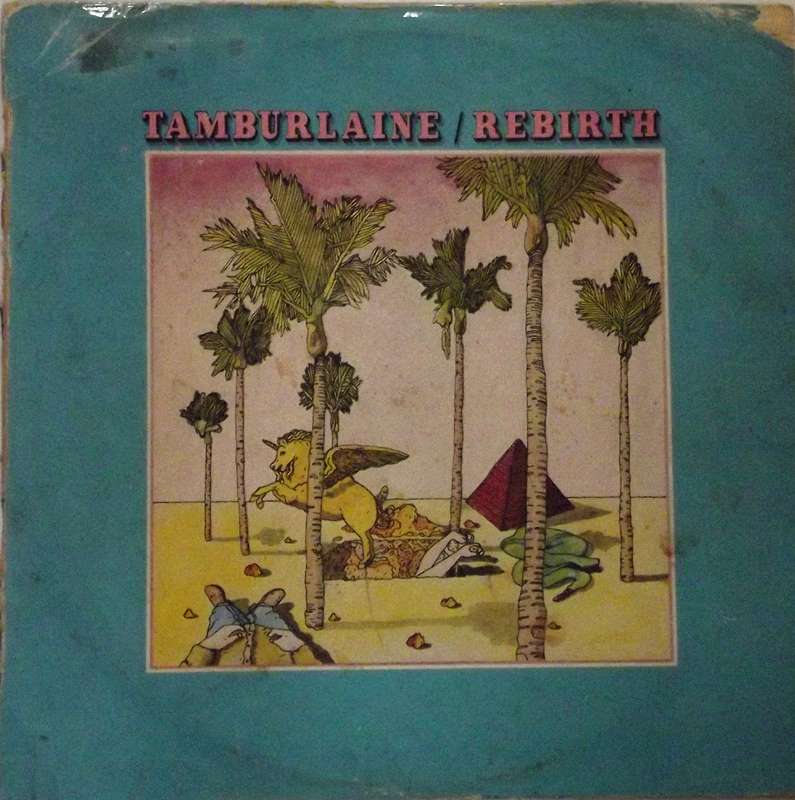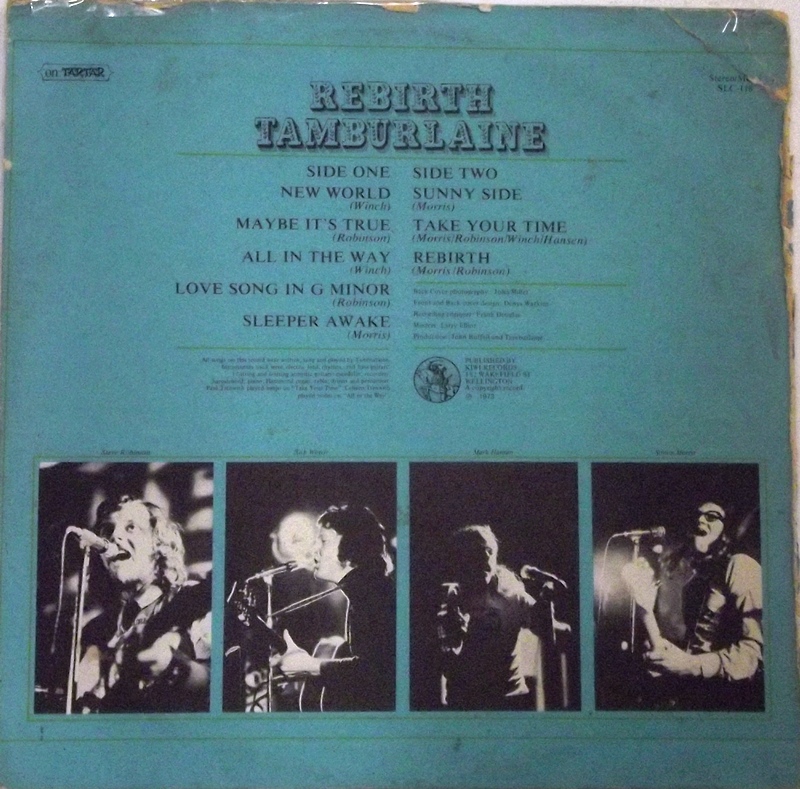

| Product Code: | SLC-118 |
| Artist: | Tamburlaine |
| Origin: | New Zealand |
| Label: | Tartar (1973) |
| Format: | LP |
| Availability: | Enquire Now |
| Condition: |
Cover: G+
Record: VG+
|
| Genre: | Rock U |
Very rare album in good condition..Cover is showing wear and has fraying around the top border with tape repair and along the spine. A wee small scrape in the very top right corner, about 1 cm. There is also a typed info sheet ( about the band ) that com
Internationally and at home in the 1970s, the softer sounds of folk rock and melodic prog swept the airwaves. Singer-songwriters gaining exposure included Shona Laing, John Hanlon, and groups Waves from Auckland, Serenity in Christchurch and Lutha in Dunedin. In the middle of it all was Tamburlaine.
Raised in Wellington’s rich musical underground, the great Tamburlaine was born from British-style blues and the folk revival, and graduated from shouty, sweaty clubs to spellbinding larger concerts.
Guitarist Steve Robinson grew up in Fiji, where he studied piano from age four, played the violin in school orchestras and learned the ukulele, which naturally led to guitar. Returning with his family to New Zealand as a young teenager, he first played bass in Christ College’s ironically named beat covers band The Pagans, and later, lead guitar with Wellington College’s Us Five.
Long before graduating to guitar, young Denis Leong studied piano for eight excruciating years, while also developing his singing voice. Backed by brother Kevin on guitar, Leong sang and together the brothers dominated 1950s talent shows, where they regularly won prizes in competition and accumulated a modest collection of toasters and other small kitchen appliances.
“I would like to say we sang early Chuck Berry or Everly Brothers tunes,” says Denis Leong, “but … our repertoire was limited to all but the cheesiest of top twenty hits.”
Meanwhile, bassist Simon Morris was playing lead guitar in his Onslow College school band Changing Times when formidable future vocalist Rick Bryant tried out for singer, but was turned down. Meeting up again with Morris at university, a newly honed Bryant fancied starting a “serious blues band”, and he and Morris bore Original Sin. “Original Sin was very much a bunch of mates into Chicago type blues (Howlin’ Wolf, Muddy Waters, etc.), pretty much driven by Rick," says Steve Robinson.
After unshackling from Rick’s harmonically-challenged brother Rod on mouth harp, the Sin really caught fire when ex-Canberran draft-dodger Bill Lake took on guitar and harmonica. Cafe L’Affare founder Jeff Kennedy played drums, rounded off, says Morris, with “a revolving door of bass-players. We could never hold onto one. Steve Robinson was one, Tony Backhouse another, [and] Lindsay Field [later an in-demand backing vocalist in Australia]."
“I went to see Original Sin perform in a school gym,” says Denis Leong. “The stage was full but the hall was empty and there was possibly just one functional amplifier. I was there because Rodney Bryant – a year younger at Rongotai College – claimed to play in a rock band. A group of fellow sixth-form skeptics went to check this out. While Rodney did not play, his older brother Rick did, ably fashioning a credible Chicago blues frontman persona in the manner of a prematurely weathered Van Morrison. More striking was another fellow who did all the talking bits between songs. This fellow told great jokes and projected a very sunny entertaining disposition … a touch at odds with the otherwise grim authentic blues ethos. That was Simon.”
Sure, Original Sin had started off playing “authentic” blues – via the Stones and The Pretty Things – but soon the Sin stepped even farther from the source when Hendrix and Cream modified the mix. Songs got longer, tempos and keys changed more, and there was more adlibbing and improvisation.
They played sporadically – including a gig for the Karori Girl Guides – and by 1968 they were the resident band at the Mystic, on Wellington’s Willis Street, a hot, smoky blues club with ultraviolet lighting.
The group started to introduce techniques which would become Tamburlaine standard practice: rich vocal harmonies and multi-instrumentalism.
Perhaps as penance for the volume and excess of Original Sin, Morris joined a jug band with fellow student Lindy Mason – the Kelburn International Airport Ceremonial Guard Band – which also featured her boyfriend and ex-bassist Steve Robinson, with Mitch Park, Mike Rashbrooke on the jug, and future Windy City Strugglers Bill Lake and Geoff Rashbrooke. Mason introduced the KIACGB to West Coast American bands Jefferson Airplane and Buffalo Springfield, and the group started to introduce techniques which would become Tamburlaine standard practice: rich vocal harmonies and multi-instrumentalism. Morris took on traditional – if somewhat silly – folk instruments like tin whistle, ukulele and kazoo, with Robinson on guitar and high harmonies. The group played the Christchurch Arts Festival in August 1967.
“The fact is, we loved singing together. Harmony vocals have been my favourite thing in bands,” says Morris.
After his two-month stint in the Sin (“I think he objected to working four hours a night for no money, or something!” says Morris) Robinson went exclusively folk. Studying sociology and anthropology at Vic, his tastes had changed from high school beat bands through the blues to Dylan, The Kingston Trio and Peter, Paul and Mary. He joined Victoria’s folk club during Orientation, and later became President with Lindy Mason as Secretary.
Wellington’s coffee house/ folk club scene was merrily percolating away, and Robinson played several times a week at these new venues: The Chez Paree at the Embassy Theatre on Courtenay Place, the Balladeer, and particularly the Monde Marie in a duo with Mitch Park, where the fee for playing was “$2 an hour plus a bowl of Hungarian goulash.”
The Original Sin’s residency had shifted from the reasonably scuzzy Mystic to the post-apocalyptic, student flat-like Mystic II, and they split up in 1969 when the academic year finished.
“Bill Lake, Tony Backhouse and I decided to form a group specialising in hard songs we could barely play,” says Morris. “Frank Zappa, Spooky Tooth, Jack Bruce – and finally a few originals.”
This first incarnation of the band is often referred to as Simon and the Mammals, but the band was just called Mammal, says Morris.
Mate Mark Hansen had a fab pad in Lyall Bay for band practice, and he signed up as their (unexpectedly short-term) drummer. Sin singer Bryant had gone on to get Gutbucket going after Original Sin, but soon joined the flocking Mammals, swapping in Gutbucket’s drummer Mike Fullerton for Hansen.
“After a while the Original Sin, and later Mammal, were quite keen on generally showing off,” says Morris. “Since none of us were exactly virtuosi, our showing off was more about keeping the audience on its toes – lots of unexpected vocal backup bits, quotes from well-known songs in the solos, that sort of thing. And in 1967, suddenly a lot of other bands overseas started doing the same thing – The Beatles of course, the Stones, then Incredible String Band, Moody Blues. I think all we wanted to do was make something a bit interesting.”
And if that wasn't interesting enough, Geoff Murphy invited the irrepressible Morris to play bass with him and Bruno Lawrence in their project The Acme Sausage Company, soon to become BLERTA. “They wanted a bass player. Could I play bass? The correct answer to this question is always ‘yes’. And fortunately I managed to borrow, and later buy, Tony Backhouse’s bass, a tiny Maton with an unbelievably narrow neck. Which meant it was incredibly easy to play. The sound of Tamburlaine – the bottom end at any rate – was entirely down to that.”